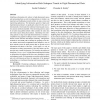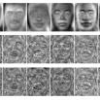169 search results - page 6 / 34 » Reductions among high dimensional proximity problems |
CORR
2012
Springer
12 years 3 months ago
2012
Springer
We study the problem of learning high dimensional regression models regularized by a structured-sparsity-inducing penalty that encodes prior structural information on either input...
ECCV
2006
Springer
14 years 9 months ago
2006
Springer
Abstract. We present a novel method for dimensionality reduction and recognition based on Linear Discriminant Analysis (LDA), which specifically deals with the Small Sample Size (S...
CVPR
2008
IEEE
14 years 9 months ago
2008
IEEE
We consider the problem of dimensionality reduction, where given high-dimensional data we want to estimate two mappings: from high to low dimension (dimensionality reduction) and f...
SDM
2009
SIAM
14 years 4 months ago
2009
SIAM
Identifying information-rich subsets in high-dimensional spaces and representing them as order revealing patterns (or trends) is an important and challenging research problem in m...
CVPR
2007
IEEE
14 years 9 months ago
2007
IEEE
A large family of algorithms for dimensionality reduction end with solving a Trace Ratio problem in the form of arg maxW Tr(WT SpW)/Tr(WT SlW)1 , which is generally transformed in...



